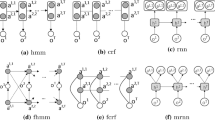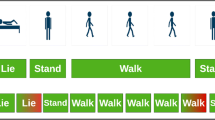Abstract
Remote activity monitoring of an old person, residing independently in a house, is a major concern in the field of geriatric care. An activity chart could be a useful tool to identify the mild cognitive impairments of the resident. Activity detection, the key thing for monitoring, is done through the analysis of sensory data, whereas sensors are placed in strategic locations within the residence. Training data set preparation is the mandatory prerequisite for activity recognition approaches. The data preparation requires repetitive execution of a specific activity that may not be feasible for an old inhabitant. Thus, a semi-supervised learning technique is used to identify daily activities with a satisfactory detection ratio. One of the novelties of the proposed solution is to discover the activities through ambient sensors as the old persons dislike to use the wearable sensors in general. Another contribution of this work is to offer an online solution that is to identify the activities based on the recent data streams. A rigorous experiment has been done to measure the performance of the said discovery technique. The algorithm is executed on benchmark data set ARUBA, TULUM, and KYOTO and it shows better results compared to the notable existing techniques in this domain.







Similar content being viewed by others
References
Elderly in India; 2016.http://mospi.nic.in/sites/default/files/publication_reports/ElderlyinIndia_2016.pdf.
Thapliyal H, Nath RK, Mohanty SP. Smart home environment for mild cognitive impairment population: solutions to improve care and quality of life. IEEE Consumer Electron Magazine. 2018;7(1):68–76.
Saives J, Pianon C, Faraut G. Activity discovery and detection of behavioral deviations of an inhabitant from binary sensors. IEEE Trans Automat Sci Eng. 2015;12(4):1211–24.
Urwyler P, Stucki R, Rampa L, Müri R, Mosimann UP, Nef T. Cognitive impairment categorized in community-dwelling older adults with and without dementia using in-home sensors that recognise activities of daily living. Sci Rep. 2017;7:42084.
Benmansour A, Bouchachia A, Feham M. Multioccupant activity recognition in pervasive smart home environments. ACM Comput Surv (CSUR). 2016;48(3):34.
Brdiczka O, Crowley JL, Reignier P. Learning situation models in a smart home. IEEE Trans Syst Man Cybern B (Cybernetics). 2009;39(1):56–63.
Logan B, Healey J, Philipose M, Tapia EM, Intille S. A long-term evaluation of sensing modalities for activity recognition. In: International Conference on Ubiquitous Computing. Springer; 1980. pp. 483–500.
Lombriser C, Bharatula NB, Roggen D, Tröster G. On-body activity recognition in a dynamic sensor network. In: Proceedings of the ICST 2nd International Conference on Body Area Networks, ICST Institute for Computer Sciences, Social-Informatics and Telecommunications Engineering; 2007, p. 17.
Fleury A, Noury N, Vacher M. Supervised classification of activities of daily living in health smart homes using svm. In: Engineering in Medicine and Biology Society, 2009. EMBC 2009. Annual International Conference of the IEEE, IEEE; 2009, pp. 6099–6102.
Vail DL, Veloso MM, Lafferty JD. Conditional random fields for activity recognition. In: Proceedings of the 6th International Joint Conference on Autonomous Agents and Multiagent Systems, ACM; 2007, p. 235.
Cook DJ, Krishnan NC, Rashidi P. Activity discovery and activity recognition: a new partnership. IEEE Trans Cybern. 2013;43(3):820–8.
Viard K, Fanti MP, Faraut G, Lesage J-J. Human activity discovery and recognition using probabilistic finite-state automata. IEEE Trans Automat Sci Eng. 2020;17(4):2085–96.
Rashidi P, Cook DJ. Mining sensor streams for discovering human activity patterns over time. In: 2010 IEEE International Conference on Data Mining, IEEE; 2010, pp. 431–440.
Aggarwal CC, Philip SY. On clustering massive text and categorical data streams. Knowledge Info Syst. 2010;24(2):171–96.
Kisilevich S, Mansmann F, Nanni M, Rinzivillo S. Spatio-temporal clustering. In: Data Mining and Knowledge Discovery Handbook, Springer; 2009, pp. 855–874.
Gjoreski H, Roggen D. Unsupervised online activity discovery using temporal behaviour assumption. In: Proceedings of the 2017 ACM International Symposium on Wearable Computers, ACM; 2017, pp. 42–49.
Krishnan NC, Cook DJ. Activity recognition on streaming sensor data. Pervasive Mobile Comput. 2014;10:138–54.
Wan J, O'grady MJ, O'hare GM. Dynamic sensor event segmentation for real-time activity recognition in a smart home context. Pers Ubiquitous Comput. 2015;19(2):287–301.
Ye J, Stevenson G. Semantics-driven multi-user concurrent activity recognition. In: International Joint Conference on Ambient Intelligence, Springer; 2013, pp. 204–219.
Yan S, Lin K-J, Zheng X, Zhang W. Using latent knowledge to improve real-time activity recognition for smart IoT. IEEE Trans Knowledge Data Eng. 2019;32(3):574–87.
Cook DJ. Learning setting-generalized activity models for smart spaces. IEEE Intell Syst. 2010;2010(99):1.
Cook DJ, Schmitter-Edgecombe M. Assessing the quality of activities in a smart environment. Methods Info Med. 2009;48(05):480–5.
Zhang T, Fu W, Ye J, Fischer M. Learning movement patterns of the occupant in smart home environments: an unsupervised learning approach. J Ambient Intell Hum Comput. 2017;8(1):133–46.
Sadri A, Ren Y, Salim FD. Information gain-based metric for recognizing transitions in human activities. Pervasive Mobile Comput. 2017;38:92–109.
Cook DJ, Crandall AS, Thomas BL, Krishnan NC. Casas: a smart home in a box. Computer. 2012;46(7):62–9.
Acknowledgements
This publication is an outcome of the R &D work undertaken project the Visvesvaraya Ph.D. Scheme of Ministry of Electronics& Information Technology, Government of India, being implemented by Digital India Corporation.
Author information
Authors and Affiliations
Corresponding author
Ethics declarations
Conflict of Interest
The authors declare that they have no conflict of interest.
Ethical Approval
This article does not contain any studies with human participants or animals performed by any of the authors.
Additional information
Publisher's Note
Springer Nature remains neutral with regard to jurisdictional claims in published maps and institutional affiliations.
This article is part of the topical collection “Social Data Science: Research Challenges and Future Directions” guest edited by Sarbani Roy, Chandreyee Chowdhury and Samiran Chattopadhyay.
Rights and permissions
About this article
Cite this article
Ghosh, M., Choudhury, S. An Online Activity Monitoring for Geriatric Care Using Ambient Sensors. SN COMPUT. SCI. 3, 339 (2022). https://doi.org/10.1007/s42979-022-01224-8
Received:
Accepted:
Published:
DOI: https://doi.org/10.1007/s42979-022-01224-8




